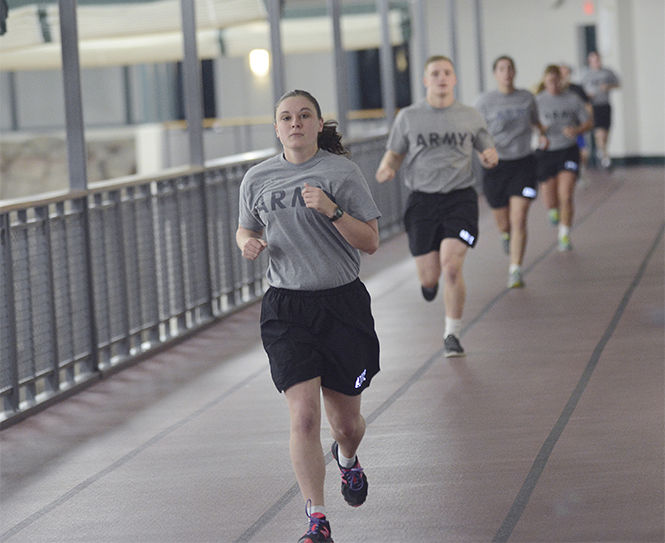Women discuss experiences and challenges in ROTC program
The Kent Stater Cadet Ellie Milner, a senior psychology major, runs two miles around the track inside the Student Recreation and Wellness Center as she trains with fellow Kent State Army ROTC cadets early Friday Jan. 23, 2015.
January 25, 2015
More than 40 years ago, women were not a part of the Army ROTC program in the United States. Today, women account for 20 percent of the program and 14.5 percent of the entire active-duty force.
On the Kent State Army ROTC website, it states the program has a “diverse group of men and women” with more than 20,000 total students enrolled.
The program continues to evolve, becoming more inclusive for women who have a desire to defend their country.
“Not a lot of people get the chance to be in the Army, and only a small percentage get to commission active duty,” said Kayla Enochs, senior exercise science major. “I think it would be awesome to be a part of the greatest military in the world.”
In a military mainly made up of men, people may wonder what it’s like being a woman in the military or if gender plays a role.
Junior finance major Brittany Martin said people often ask her these questions.
“People expect a terrible answer compared to what I give them,” Martin said. “No one has ever told me I’m completely incompetent or weaker because I’m a woman. If people look at me like I’m incompetent, it’s because I don’t know what I’m doing and I’m still learning. It’s never been because of my gender.”
With more women becoming involved with the military, the armed forces as a whole are beginning to look past treating gender as a weakness.
Sophomore psychology major Tiffany Gainer said that when she first joined the National Guard in July 2013, she wanted to join infantry but was told she was not allowed because of her gender.
“When you look at the military, they are typically seen as masculine,” Gainer said. “Luckily, they are starting to change some of the rules. Women will be allowed to join infantry in the next couple years, and we just were allowed to join ranger school.”
Military officers, whether male or female, are expected to uphold high standards during training and in the field. These expectations do not change based on gender.
“I think both men and women are treated pretty fairly,” Enochs said. She explained female standards for things like physical training tests are lower than male standards, but the expectations are set appropriately for both genders.
Martin said she agrees the program has progressed greatly and has created a path for more equal opportunities among men and women.
“I’ve always done the most feminine things possible and being thrown into a male-dominated career field is tough,” Martin said. “But they teach you everything along the way.”
Finding time to balance a military career with school, work and a personal life can be difficult for ROTC students.
Enochs, a Kent State cheerleader, understands the balancing act between the Army lifestyle and the other end of spectrum. “It can be difficult sometimes,” she said. “With the Army I have to be tough and stand my ground, and with cheerleading I have to personable, talkative and happy all the time.”
The biggest problem for women or anyone involved with the military, however, doesn’t come from their gender but from finding the drive to stay committed.
“You have to find the discipline, passion and drive. That’s what the Army is all about,” said Martin
Though being a woman in the military can be difficult in a male-dominated career, it gives support and motivation through not only physical strength but mental strength as well.
“There is no way I could have accomplished some of the things I have done if it wasn’t for the military,” Gainer said. “They have mentally strengthened me beyond anything I could have imagined.”
Contact Sky Fought at [email protected]












